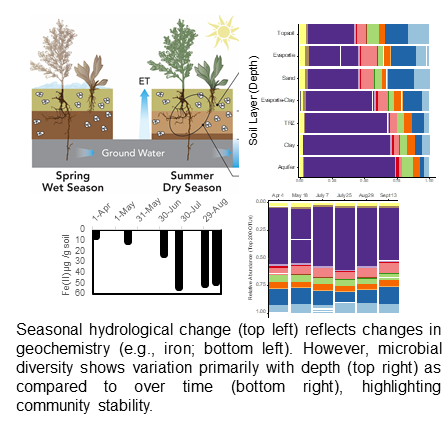- Home
- Research program
- Research highlights
- Exported organic carbon promotes reducing conditions and redox cycling in oxic aquifers
- Soil organic matter controls Pb release during redox cycles in floodplain soils
- Spatial and Compositional Heterogeneities Control Zn Retention Mechanisms in a Simulated Aquifer
- Calcium-Uranyl-Carbonato Species Kinetically Limit U(VI) Reduction by Fe(II) and Result in U(V)-bearing Ferrihydrite
- Diverse Ammonia-Oxidizing Archaea Dominate Subsurface Nitrifying Communities in Semi-Arid Floodplains
- A Simplified Way to Predict the Function of Microbial Communities
- Complexation Organic Matter Controls Uranium Mobility Anoxic Sediments
- FES-Nanoclusters can mobilize Fe and S from sediment to the groundwater
- Hexavalent uranium storage mechanisms in wet-dry cycled sediments at contaminated DOE sites in the Western U.S.
- Redox-Interfaces can Produce Toxic Arsenic Levels Groundwater...
- Sorption to Organic Matter Controls Uranium Mobility
- Thermodynamic preservation of carbon in anoxic environments
- Iron and sulfur cycling in NRZs controlled by sediment textural and hydrology
- A regional model for uranium redox and mobility
- Long-Term in Situ Oxidation of Biogenic Uraninite in an Alluvial Aquifer: Impact of Dissolved Oxygen and Calcium
- U Release from NRZ sediments is inhibited by Transport and Geochemistry
- Team
- Previous research
- Publications
 Fine-grained sediments appear to host distinct microbial groups that are stimulated through water table rise and fall throughout the season
Fine-grained sediments appear to host distinct microbial groups that are stimulated through water table rise and fall throughout the season
The Science
Microbial communities play a crucial role in environmental systems, mediating biogeochemical reactions through metabolic processes that can vary depending on environmental conditions. Understanding these metabolic shifts is particularly important in soils closely connected to ground- and surface-water (such as those in floodplains) where redox transformations can determine if contaminants are sequestered or mobilized. In this study we characterized microbial community diversity at the uranium- and molybdenum-contaminated Riverton, WY, site from spring to fall across multiple depths. Our results indicate that communities are surprisingly stable over time, despite extreme seasonal geochemical changes (redox inversion) and hydrological changes (flood-to-drought). This finding suggests that these microorganisms oscillate between ‘active’ and ‘dormant’ depending on current environmental conditions, and the products of their metabolism play a greater role in contaminant mobility than the organisms themselves. Future studies to investigate metabolic capacity and activity through metagenomic and metatranscriptomic sequencing will support further integration of hydrological, geochemical, and microbial data into models and other knowledge of contaminant transport and mobility.
The Impact
Biogeochemical changes in the subsurface are driven primarily through microbial life and their metabolic responses to environmental conditions around them. Soil moisture content, which varies throughout the season from spring flooding to summer drought, profoundly influences microbial communities and the availability of O2, thus affecting soil redox conditions and water quality. Microbial responses to hydrologic changes therefore comprise keystone functionality within subsurface ecosystems; however, it is not fully understood how large changes in soil moisture and O2 impact subsurface microorganisms themselves or their metabolism. In this study, surprisingly, microbial communities did not change significantly during seasonal flood-to-drought transitions. Rather, we found that depth within the soil profile and soil horizon characteristics were the strongest factors determining microbial diversity. These results provide insight into the complexity of coupling (or decoupling) microbial and geochemical trends in floodplain soils over space and time. For example, seasonal changes in soil moisture apparently are not sufficiently prolonged to displace established microbial groups.
Summary
Riparian floodplains are important regions given the connectivity of groundwater with river water, biodiversity, presence of contaminants, and capacity to generate and recycle nutrients. In a given year, these floodplains experience changes in precipitation, river discharge (including flooding), and water content (including drought), which impact water quality. For example in the Western US, the DOE manages several former uranium ore processing floodplain sites, where contaminant concentrations change in response to changing sediment moisture and season. There is a need to understand how hydrology, geochemistry, and microbiology interact to drive these changes. In this study, we collected floodplain soil samples through a full growing season at the uranium-contaminated Riverton, WY, DOE legacy site. These samples were analyzed for key geochemical species, water content, and microbial diversity through community DNA analysis. We showed that despite clear seasonal shifts in geochemical and redox conditions corresponding to changes in hydrological conditions (such as flood and drought), microbial community diversity remained largely unaffected. The same microbial groups were present at a given depth throughout the year, indicating their ability to persist despite environmental change. We did, however, observe slight differences in soil surrounding fine-grained, organic-rich layers (referred to as “Transiently Reduced Zones”, or TRZs). This agrees with previously observed export of reducing conditions from TRZs, but adds information about how these exports may also impact microbial diversity in adjacent soil layers through water table fluctuations. The results suggest that TRZ soil layers are even more important to floodplain functions than presumed by commonly observed redox transformations, because of stable microbial communities driving geochemical changes while remaining relatively unchanged themselves.
Contacts (BER PM)
Amy Swain
DOE Office of Biological and Environmental Research, Climate and Environmental Sciences Division
Amy.Swain@science.doe.gov
(PI contact)
John Bargar
SLAC National Accelerator Laboratory, Stanford Synchrotron Radiation Lightsource
Bargar@slac.stanford.edu
Funding
Funding was provided by the DOE Office of Biological and Environmental Research, Subsurface Biogeochemistry Research (SBR) activity to the SLAC SFA program under contract DE-AC02-76SF00515 to SLAC. Use of SSRL is supported by the U.S. DOE, Office of Basic Energy Sciences.
Publications
Tolar, B.B., Boye, K., Bobb, C., Maher, K., Bargar, J.R., Francis, C.A. Stability of floodplain subsurface microbial communities through seasonal hydrological and geochemical cycles. Frontiers in Earth Science – Biogeoscience (in revision).





